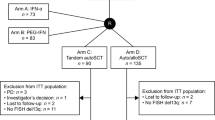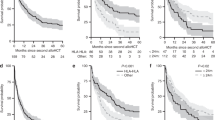Abstract
Patients with myeloma relapsing after tandem transplant have a poor survival and treatment options are limited. The role of additional salvage transplant procedures for these patients is unknown. To evaluate the benefit and identify prognostic factors, the outcome of 76 consecutive patients with recurrent myeloma after tandem transplant receiving salvage transplants (ST) was analyzed. Prior to ST, 23 patients (30%) had shown chemosensitive response to preceding salvage chemotherapy: two complete remissions (CR); eight near CRs (nCR: only immunofixation positive); 13 partial remissions (PR ⩾75% reduction in M protein). Fifty received an autologous transplant, 22 a sibling-matched allogeneic transplant, and four a matched-unrelated allogeneic transplant. Overall response after ST was 59%: eight CRs (11%); 14 nCRs (18%); 23 PRs (30%). Overall survival (OS) at 2 years was 19%; 2 year event-free survival rate (EFS) 7%. On univariate analysis for survival, only pre-transplant chemosensitive relapse (P < 0.05), serum albumin >3 g/dl (P = 0.001), normal LDH (P = 0.04), and long interval between the second transplant and relapse/progression were significant beneficial factors. In a Cox proportional hazard model, chemosensitive relapse, and albumin >3 g/dl were significant for better OS: hazard ratio (HR) 1.4, 1.7, respectively, while normal LDH, and absence of CA13 were significant for better EFS: HR 1.8, 1.7, respectively. Patients with albumin >3 g/dl who had chemosensitive disease before ST (n = 16) had a median survival of 16 months, compared to 7 months (n = 34) and 2 months (n = 26) for patients with only one (n = 34) or no favorable prognostic factors (n = 28), respectively (P < 0.001). Their survival at 2 years post-ST was 43%, 17% and 11%, respectively. Our study suggests further transplantation should only be considered in the setting of a clinical trial in patients with favorable prognostic factors.
This is a preview of subscription content, access via your institution
Access options
Subscribe to this journal
Receive 12 print issues and online access
$259.00 per year
only $21.58 per issue
Buy this article
- Purchase on Springer Link
- Instant access to full article PDF
Prices may be subject to local taxes which are calculated during checkout


Similar content being viewed by others
References
Selby PJ, McElwain TJ, Nandi AC et al. Multiple myeloma treated with high dose intravenous melphalan Br J Haematol 1987 66: 55 62
Barlogie B, Hall R, Zander A et al. High-dose melphalan with autologous bone marrow transplantation for multiple myeloma Blood 1986 67: 1298 1301
Barlogie B, Alexanian R, Dicke KA et al. High-dose chemoradiotherapy and autologous bone marrow transplantation for resistant multiple myeloma Blood 1987 70: 869 872
Lenhoff S, Hjorth M, Holmberg E et al. Impact on survival of high-dose therapy with autologous stem cell support in patients younger than 60 years with newly diagnosed multiple myeloma: a population-based study. Nordic Myeloma Study Group Blood 2000 95: 7 11
Attal M, Harousseau JL, Stoppa AM et al. A prospective, randomized trial of autologous bone marrow transplantation and chemotherapy in multiple myeloma. Intergroupe Francais du Myelome New Engl J Med 1996 335: 91 97
Barlogie B, Jagannath S, Desikan KR et al. Total therapy with tandem transplant for newly diagnosed multiple myeloma Blood 1999 93: 55 65
Attal M, Harousseau JL . Randomized trial experience of the Intergroupe Francophone du Myelome Semin Hematol 2001 38: 226 230
Fassas A, Tricot G . Results of high-dose treatment with autologous stem cell support in patients with multiple myeloma Semin Hematol 2001 38: 231 242
Tricot G, Jagannath S, Vesole DH et al. Relapse of multiple myeloma after autologous transplantation: survival after salvage therapy Bone Marrow Transplant 1995 16: 7 11
Barlogie B, Desikan R, Eddlemon P et al. Extended survival in advanced and refractory multiple myeloma after single-agent thalidomide: identification of prognostic factors in a phase 2 study of 169 patients Blood 2001 98: 492 494
Barlogie B, Zangari M, Spencer T et al. Thalidomide in the management of multiple myeloma Semin Hematol 2001 38: 250 259
Hideshima T, Richardson P, Chauhan D et al. The proteasome inhibitor PS-341 inhibits growth, induces apoptosis, and overcomes drug resistance in human multiple myeloma cells Cancer Res 2001 61: 3071 3076
Hideshima T, Chauhan D, Shima Y et al. Thalidomide and its analogs overcome drug resistance of human multiple myeloma cells to conventional therapy Blood 2000 96: 2943 2950
Mansi JL, Cunningham D, Viner C et al. Repeat administration of high dose melphalan in relapsed myeloma Br J Cancer 1993 68: 983 987
Badros A, Barlogie B, Siegel E et al. Improved outcome of allogeneic transplantation in high-risk multiple myeloma patients after nonmyeloablative conditioning J Clin Oncol 2002 20: 1295 1303
Gooley TA, Leisenring W, Crowley J et al. Estimation of failure probabilities in the presence of competing risks: new representations of old estimators Stat Med 1999 18: 695 706
Desikan R, Barlogie B, Sawyer J et al. Results of high-dose therapy for 1000 patients with multiple myeloma: durable complete remissions and superior survival in the absence of chromosome 13 abnormalities Blood 2000 95: 4008 4010
Bjorkstrand B . European Group for Blood and Marrow Transplantation Registry studies in multiple myeloma Semin Hematol 2001 38: 219 225
Corradini P, Voena C, Tarella C et al. Molecular and clinical remissions in multiple myeloma: role of autologous and allogeneic transplantation of hematopoietic cells J Clin Oncol 1999 17: 208 215
Cavo M, Terragna C, Martinelli G et al. Molecular monitoring of minimal residual disease in patients in long-term complete remission after allogeneic stem cell transplantation for multiple myeloma Blood 2000 96: 355 357
Bosi A, Laszlo D, Labopin M et al. Acute Leukemia Working Party of the European Blood and Marrow Transplant Group. Second allogeneic bone marrow transplantation in acute leukemia: results of a survey by the European Cooperative Group for Blood and Marrow Transplantation J Clin Oncol 2001 19: 3675 3684
Author information
Authors and Affiliations
Rights and permissions
About this article
Cite this article
Lee, CK., Barlogie, B., Zangari, M. et al. Transplantation as salvage therapy for high-risk patients with myeloma in relapse. Bone Marrow Transplant 30, 873–878 (2002). https://doi.org/10.1038/sj.bmt.1703715
Received:
Accepted:
Published:
Issue Date:
DOI: https://doi.org/10.1038/sj.bmt.1703715
Keywords
This article is cited by
-
The changing landscape of relapsed and/or refractory multiple myeloma (MM): fundamentals and controversies
Biomarker Research (2022)
-
Rationale and design of the German-Speaking Myeloma Multicenter Group (GMMG) trial ReLApsE: a randomized, open, multicenter phase III trial of lenalidomide/dexamethasone versus lenalidomide/dexamethasone plus subsequent autologous stem cell transplantation and lenalidomide maintenance in patients with relapsed multiple myeloma
BMC Cancer (2016)
-
Treatment strategies in relapsed and refractory multiple myeloma: a focus on drug sequencing and ‘retreatment’ approaches in the era of novel agents
Leukemia (2012)
-
Cure of multiple myeloma – more hype, less reality
Bone Marrow Transplantation (2006)
-
Novel treatment approaches for patients with relapsed and refractory multiple myeloma
Current Treatment Options in Oncology (2006)



